How To Create An App On Blockchain
Decentralized exchanges, crypto wallets, and peer-to-peer loan platforms are just the tip of an iceberg in the booming market of blockchain apps. Who could have thought that you can run a distributed healthcare or fintech application where both consumers and providers have an equal say in how data gets aggregated and shared? Today, the distributed ledger technology (DLT) makes such a solution a reality.
If you're looking for tips on how to create a blockchain application and join the decentralized apps (aka dapps) revolution, you're in the right place. We'll discuss everything you need to know about building a dapp.
Table of Contents:
- What Are Blockchain Apps?
- Blockchain App Market Overview
- Popular Apps Using Blockchain
- Benefits of Blockchain Apps
- Types of Blockchain Based Application Development
- How to Develop a Blockchain Application
- How Does a Blockchain Application Work?
- Our Experience Creating Blockchain Apps
What Are Blockchain Apps?
Before we discuss blockchain app development, let's quickly recap what blockchain (aka DLT) and blockchain apps really are. After all, this technology directly relates to the most fundamental layer of dapp applications.
If we step back a little and think about why we use apps, we'd have to admit that every application stores, processes, and shows us some data. Take the Stocks app on your phone: price charts, industry news, indexes — it's all data, fetched by the app, processed, and displayed in the most digestible format. Take this data away, and the app becomes an empty shell.

For a regular app (99% of today's software), data lives on centrally controlled servers owned by a company that built an app. For example, Apple's Stock app uses the company's servers that pull info from exchanges and news sites and then serve it to users through the app's interface. The key here is Apple solely controls how the app's data is processed and served to customers.
Contrary to that approach, blockchain technology in healthcare has pushed a new type of database to the tech scene — the one without a central authority but with a self-containing security mechanism. It's a distributed database that:
- exists on many computers simultaneously
- algorithmically verifies new data before it's added to the database
- protects all data from overwriting, editing, or deleting
- provides full transparency into its state, including all updates

In that sense, any app — whether mobile or web — relying on a distributed database is a blockchain app. There you have it! Your blockchain app may look like another web or mobile app to consumers. However, if it operates off a distributed ledger on the inside, it's a blockchain app, also referred to as a distributed app or simply dapp.
Blockchain App Market Overview
To get some understanding of what the blockchain app market looks like, you need to know three simple facts:
- There are different types of blockchains out there to power your dapp
- A blockchain app can run on a permissioned chain (requires access rights) or on a permissionless (publicly accessible) chain
- DLT is still a nascent technology, and virtually any application is possible
Chain apps out in the wild
Most people immediately think of Bitcoin when they hear blockchain, but in the context of blockchain application development, Bitcoin is actually useless. This chain is purely for transactions, and you can't build distributed apps on its protocol.
If your goal is creating a dapp, the most popular choice is Ethereum (smart contract development). This chain supports smart contracts — self-executing algorithms that fire off when preprogrammed conditions are met.
Other blockchain platforms that allow building dapps include EOS, TRON, Steem, and a few others. At the same time, these other chains host considerably fewer blockchain apps compared to Ethereum:
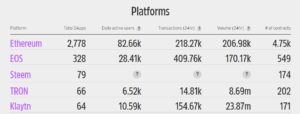
That's probably because Ethereum nodes became the powerhouse for the second-largest cryptocurrency in the world and because it offered the core technology for building distributed apps — smart contracts.
Private & public blockchains
Please note that the number of dapps available on Ethereum and other chains we've just covered includes only those public distributed apps that work right on blockchains. That means they can be freely accessed by any member of the chain.
There are also many permissioned (aka private) blockchain apps that exist off main chains. Such applications can be used only by authorized users and have broader adoption in the business world.
Types of blockchain apps
As I've mentioned above, blockchain apps still remain terra incognita, and, therefore, any idea for a distributed app holds potential. However, if we consider the types of chain apps that have gained the most traction today, we'll notice lots and lots of finance-related solutions.
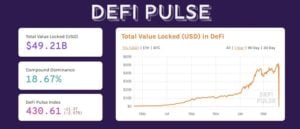
These distributed apps go by the name of DeFi — decentralized finances. DeFi solutions include a wide range of financial apps: from crypto loaning applications to decentralized exchanges to crypto wallets to payment tools, to name just a few.
You can also build blockchain apps in other popular categories such as:
- games and gambling
- identity and security management
- insurance
- marketplaces
- decentralized healthcare
- supply chain solutions

Popular Apps Using Blockchain
To stir your imagination, let's look at some of the popular blockchain-based applications.
Brave — a web browser
Brave is an open-source web browser built on the Chromium engine, aiming to overturn the whole advertising paradigm on the internet. The browser blocks all regular ads on web pages and disables any third-party tracking services, bringing back private browsing to the customer.

Brave uses an internal cryptocurrency to pay users for watching ads separately from their browsing experience and to reward publishers who generate the most user-engaging content.
Binance — a crypto exchange
Binance is a typical case of a DeFi chain-based application. This cryptocurrency exchange allows customers to trade various crypto tokens and earn interest by staking their crypto on the platform.

KYC-Chain — a compliance solution
KYC-Chain helps companies to comply with KYC, AML, and other regulations. Using the KYC-Chain platform, businesses can verify customers' identities and streamline their KYC onboarding processes.

Compound — autonomous interest rate protocol
Compound Finance is another example of a DeFi application for borrowing and lending cryptocurrencies. Users join this decentralized platform to lend or borrow crypto assets based on real-time supply and demand.

Trust Wallet — crypto wallet
Trust Wallet is a multi-coin wallet for securely storing and exchanging crypto assets. The product is available for both iOS and Android mobile platforms and supports all Ethereum-based digital tokens.

Benefits of Blockchain Apps
When you plan to create a blockchain-based application, the last thing on your mind is the hype surrounding the technology. You need some tangible value that DLT can bring over to your solution.
Fortunately, you can expect all decentralized tech's advantages to carry over into your distributed application. First and foremost, I'm talking about cost reduction, transparency, security, and autonomy.
Reduced costs
Blockchain-based applications aim to improve business processes by removing any intermediaries and third parties from workflows. As a result, the cost of performing the same services while using fewer resources goes down.
Transparency
All users of a dapp have complete visibility into what's happening in the app, and that's often one of the main reasons to opt for a dapp instead of a traditionally architected application.

Let's say a clinic and an insurance provider decide that they can significantly streamline their cooperation by getting their internal workflows mutually transparent for each other. The development of a blockchain app can help them achieve this new level of collaboration without creating additional overheads.
Security
A properly-built dapp is more secure than any regular app by default simply because of the way that blockchain technology functions. Its mechanism prevents data from being erased or tampered with, and any updates to the app require consensus among all application users. In addition, all data is strongly encrypted.
Autonomy
A DLT application can authorize certain actions on its own by using smart contracts. These mini-apps, built into a dapp, trigger when preconfigured conditions are met. For example, a decentralized app can connect to a service reporting delayed or canceled flights and automatically initiate payouts to affected passengers.
Key industries that can benefit by investing in blockchain application development include:
- Finances
- Insurance
- Healthcare
- Real estate
- Retail
- Travel
Types of Blockchain Based Application Development
Depending on your goals with a dapp, you can build different types of dapps using permissionless or permissioned blockchain architecture.
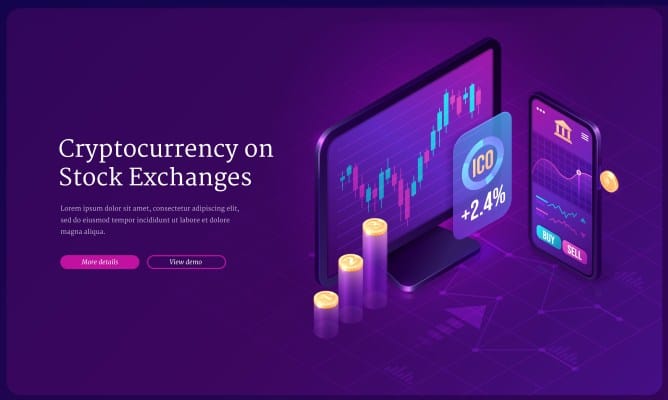
Public
Public (aka permissionless) decentralized apps are open to all members of the mainnet (e.g., Ethereum) that you choose for deploying your dapp. Clearly, that approach is often preferred for DeFi solutions and crypto games when blockchain app developers want to attract as large an audience as possible.
Private
Private (aka permissioned) dapps can be used only by authorized users. Transparency, data integrity, and all other DLT characteristics still have an effect in such decentralized apps, but only for authorized users.
Consortium
Consortium blockchain apps belong to private dapps. The difference is consortium dapps are developed by a group of companies who jointly control how the application functions and who can work with it.
How to Develop a Blockchain Application
How do you approach a blockchain-based application development project? How do you create a dapp that holds true to its promise and really disrupts a niche with its shared economy without app development costs going through the roof? Here are a few things to consider as you start a blockchain app.
Step 1: Define the purpose
First of all, you need to decide who will use your app and how they will benefit from working specifically with a decentralized application. Based on this decision, you will build a private or public decentralized solution, limiting or providing public access to the app accordingly.
Development of a dapp makes perfect sense when:
- you need to create an economically fair environment for all involved parties
- you want to avoid having a central authority police the app's functionality
- you strive to have complete transparency into all data modifications in the app
- you plan to automate processes that can be simply translated into algorithms

Step 2: Verify your idea with a prototype
Remember that your dapp should still feature a modern user interface to successfully solve the user's pain points. To this effect, a dapp competes with every other centrally controlled app that helps customers address the same issues.
Therefore, a blockchain app should first be prototyped as a clickable shell of an application and tested with real users. That way, you check whether users are likely to engage with it once the app is released out in the wild.
Whether it's going to be a mobile or a web solution, rapid prototyping will help you verify your idea with customers without spending money on coding — the most expensive part of the app development process.
Step 3: Create the user-facing part of a distributed application
Once you're done verifying the prototypes with users, it's time to put flesh on the front end of your dapp. As we've discussed, your solution can be a mobile or web solution, and you should choose the tech stack accordingly to build it.
We recommend picking a modern tech stack that will simplify further maintenance and support of your product. For a web-based solution, it safe to pick from these:
- React/Vue, Express.js, and Node.js with MongoDB or good old MySQL
- Sames as above, except Angular is used for building the customer-facing part
If you're also branching out into mobile, we advise the following technologies:
- Swift for developing an iOS app
- Kotlin or Java for creating an Android app
- Pick React Native if you need to cover both mobile platforms
Step 4: Build the backbone of your dapp
I bet you know that every app consists of more than a consumer-facing front-end part and also leans on a back end — databases, servers, business logic, well, everything that keeps the front end running.
Dapps are no different in that respect, except they tend to have two back ends. One back end is blockchain-based, consisting mainly of smart contracts. And the other one is similar to back ends you find in regular apps — a web server exchanging and processing data.
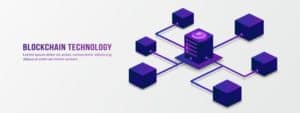
Step 5: Know your toolset
When you hire a blockchain app developer, make sure they are familiar with the following technologies. Please note that it's extremely rare (and costly) to find a developer who knows and has hands-on experience with all of these development techniques:
JavaScript (React/Vue)
- front-end development
- smart contracts testing
Python , Go , Rust , C++
- back-end coding
- business logic development
Node.js , Solidity
- smart contract development
Truffle
- developing smart contracts with the Solidity programming language
- testing blockchain code
MetaMask
- Ethereum wallet
- provides chain connectivity inside a browser
Ganache
- spin up a local blockchain in seconds with funded accounts
- cheap alternative to setting up a full-fledged testing environment
Web3.js or Ether.js
- connects the front-end portion of a dapp with a blockchain
Express.js
- off-chain back-end development
Remix
- browser-based development environment for writing blockchain code
Note that you will need front-end and server-side developers for building applications with blockchain.
Step 6: Testing decentralized apps
After building a blockchain app, you need to thoroughly check it for any discrepancies and bugs. Especially if it's a public dapp deployed to a mainnet because there's no easy way to fix it once you deploy it.
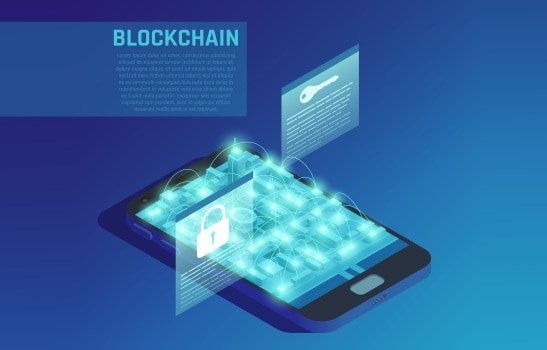
Remember that testing a dapp should include both UX testing of interfaces and integration testing that uncovers any issues in how your app connects with third-party solutions.
In an ideal scenario, you release a copy of your decentralized app to Blockchain Testnet and have real users go through the main steps of using the software while you catch all lingering bugs.
Related: Mobile App Usability Testing
Step 7: Launching a dapp
When you're launching a dapp, you are effectively releasing several applications:
- deploying consumer-facing mobile apps to the App Store and Google Play
- setting up a consumer web application on a cloud service, such as AWS
- deploying blockchain code to the mainnet
This release approach guarantees you'll be able to update different parts of your dapp as you see fit in the future.
Hopefully, these 7 steps have shed some light for you on how to make a blockchain application.
How Does a Blockchain Application Work?
You should already have a pretty solid understanding of how decentralized applications function from what we've already discussed. But if you're still struggling to grasp this concept, let's break it down in simple terms whether you're building a fintech app or a healthcare app.
Customer applications
When you're building an app on blockchain technology, it doesn't mean your customers will need to interact with something unfamiliar or overwhelming. On the surface, people will continue using software featuring (hopefully) friendly and straightforward user interfaces.
Your solution can be:
- a mobile application
- a web portal
- or even a mixture of both
In fact, it can be as comfy as Gmail if Google one day decided it would be a great idea to make emailing completely public and transferred Gmail's back end to a blockchain network.
Core blockchain platform
At the same time, the core blockchain component of your decentralized application, hidden behind the glossy user interfaces, remains responsible for executing, verifying, and logging all transactions happening in the application.
It doesn't matter whether the product is built on a private, public, or consortium distributed ledger. What matters is all users of the dapp have equal access and visibility into all operations happening in the solution. That's where you'll keep:
- blockchain code
- smart contracts
APIs
APIs are sort of links connecting your front end applications with the core decentralized component of your dapp. Besides that, an API can provide connectivity between your decentralized application and other third-party platforms.
An easy way to think about APIs in the context of blockchain app development is to imagine a set of rules, explained via code, describing how a blockchain solution can exchange data with other systems.
Our Experience Creating Blockchain Apps
At Topflight, we're developing a cryptocurrency app in the DeFi space that will compete with solutions like Celsius or Gemini, where users will be able to easily buy crypto with a credit card.
We're also working on launching a decentralized auctioning platform that will work as a hub for small businesses to team up and consolidate their supply purchasing power to compete with large chains like Krogers.
Reach out today if you're planning a decentralized marketplace, healthcare, or fintech application.
Frequently Asked Questions
How long does it take to make a blockchain app?
Depending on the complexity of the solution, between 3-4 months.
How much does it cost to build a blockchain application?
An MVP will often fit within the $80,000 budget, whereas you can expect to cash out around twice as much for a full-fledged distributed application.
Should I build a dapp on a private or public chain?
If you're targeting the general public, use a public blockchain. If you're not ready to share the app's data with everybody on the internet, revert to a private decentralized solution.
What are the must-have blockchain development tools?
Solidity, Truffle, Ganache, and Blockchain Testnet. Make sure your blockchain app developer is well versed in this tech stack.
How do I connect my blockchain app to external data sources?
For these purposes, you should use oracles .
When I create an application using blockchain, will its data reside in secure cloud storage?
You may pick various architectures, including those where some of the application's data is kept in a cloud service. However, the transactional data should remain on the blockchain itself. In this case, it's not in cloud storage but in a peer-to-peer blockchain network. This transactional data will exist on every device that's connected to the chain.
Can I create an application on blockchain that is purely mobile?
You can't avoid developing the back end (aka server-side) of your dapp simply because mobile devices do not have enough capacity for prolonged connectivity on the network: not enough storage and relatively short battery life.
X
1 out of 10,000 Apps is a Success. How do you ensure it's yours?
Konstantin has worked with mobile apps since 2005 (pre-iPhone era). Helping startups and Fortune 100 companies deliver innovative apps while wearing multiple hats (consultant, delivery director, mobile agency owner, and app analyst), Konstantin has developed a deep appreciation of mobile and web technologies. He's happy to share his knowledge with Topflight partners.
Looking for help with your app?
From a prototype to a full-blown app, we'll help you hit the market
in record time with a product that's set to win.
We can help with:
Schedule a Consultation
 Strategy
Strategy
From a prototype to a full-blown app, we'll help you hit the market in record time with a product that's set to win.
 Design
Design
Your app will have a unique visual appeal engaging your customers way beyond average digital experiences.
 Development
Development
We'll pick relevant technology pieces for your app to make it secure and easy to scale up and maintain.
Schedule a Consultation
How To Create An App On Blockchain
Source: https://topflightapps.com/ideas/how-to-develop-a-blockchain-application/
Posted by: lewisovelly1950.blogspot.com

0 Response to "How To Create An App On Blockchain"
Post a Comment